
First and Only Weekly Online Fanzine Devoted to the Life and Works of Edgar Rice Burroughs
Since 1996 ~ Over 10,000 Web Pages in Archive
presents
Volume 3649

DOORWAYS TO PELLUCIDAR:
ISLAND OF THE SKULL
By Rick JohnsonIf you ask a hundred people on the street the following question, “Where would I go to see living dinosaurs?” most will reply “Kong Island” or “Skull Island” or “Island of the Skull!” with Maple White Land being a not-so-close second. King Kong is THAT famous.
But despite this fame, what we know about The Island of the Skull isn’t much. We do not even know the island’s real name as it is often called by many names, some of which I mentioned in the preceding paragraph. Even the exact location is but a guess. You go to Sumatra, head west to 2 degrees south by 90 degrees east, then head SW until you hit a fog bank and if you manage to penetrate the reefs hidden within that bank, you will find an island that has a general shape of a skull!
This puts it at about 600 miles west of Pulau Nias just off the coast of Sumatra. Or rather, the starting point is about 600 miles west of Nias!
Even the first known map of the island is in question. In 1931, Carl Denham purchased it from Nils Helstrom, the captain of a Norwegian Barque who had, in 1925, found a canoe filled with dead and dying (Negro) natives. One lived long enough to describe (presumably in the Nias Islander dialect) the island and its location. BUT, Captain Helstrom had never been there and the map he drew came from the description of a dying man in a language in which neither was fluent. The island is unnamed but described as having a cliff in the shape of a skull, hence its common name of ‘Skull Island”. [King Kong, 1933 & Son of Kong, 1934] Later, Captain Helstrom changed his story to include hidden treasure and to claim that he had received the map and description from a former US Navy Diver who he had found dying in a lifeboat. In 1976, a satellite radar map of the island was obtained by Petrox Oil Company which revealed a coincidental shape of a human skull. [King Kong 1976]
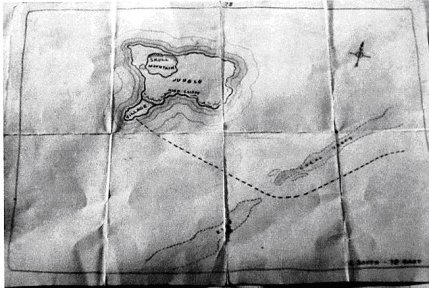
Helstrom’s map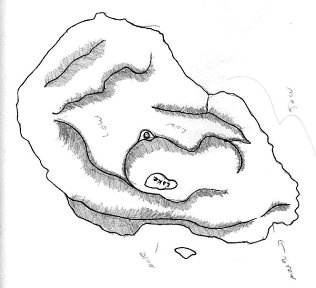
Petrox satellite imageYears later Carl Denham hired Captain Englestrom and his steamship, the Wanderer, to travel to the island. Note that the Wanderer does 14 knots so if we knew how long it took to go from 2x90 to the island, we could pinpoint the location exactly.
Denham explains that Helstrom told him that (again, second-hand and probably in the Nias language) there are ancient ruins and a Wall that is older than anyone knows but maintained to keep them safe from Kong. Kong being a Malay god or devil.
Barque, a sailing ship that really doesn’t fit any established category. They were popular as cargo ships in the Indian and Pacific oceans until the 1960s.
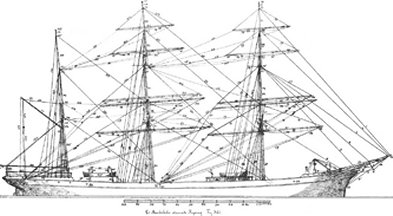
BarqueSince then, there have been many maps and reports made, but few can be considered to be accurate. I suspect that the people making these maps and films were more concerned with survival than cartography. It is also possible that the island changes often due to volcanic activity.
After the unfortunate King Kong Incident in New York City that led to multiple lawsuits, Denham again met with Captain Helstrom, learned of a treasure on the island and convinced Captain Englehorn that finding that treasure would solve their financial problems. Thus was the second expedition made by The Wanderer to the Island of the Skull. Treasure was found, and lost, and both Englehorn and Denham insisted that the island had been destroyed in a massive volcanic eruption.
Ok, before we go further, do a quick library or Amazon or Google search to see just how many books and movies are on the market using just ‘king kong’ as a parameter. It is almost impossible to cover then all unless you are willing to devote your full-time to this project. Just sifting the best [King Kong by Miriam C. Cooper 1934] from the worst [My Side by King Kong, 2005] is a monumental task. Few places and incidents have captured the public’s eye as did the Kong rampage of 1933. So let us lay down a few ground rules.
First: Primary Sources are those related to the 1933 incident by people directly involved. This includes two films and a written record. King Kong 1933; Song of Kong 1934; King Kong novel, 1934.
Second: Secondary sources are research papers based on the primary source. Den Valdron’s papers on Kong as many others come to mind as is the collection “Girl in the Hairy Paw” by Ronald Gottesman, editor.
Third: Tertiary sources are films and books based on the various rediscovery of the island. King Kong 1976, king Kong 2007, the novels based on these films, World of Kong 2005 by WETA, etc.
Fourth: questionable papers on the subject. But seemingly authentic enough to consider. Kong; King of Skull Island by Brad Strickland is one of these.
We will NOT consider the various knock-offs that seek to ride the fame for a few quick bucks. King Kong vs Godzilla or the supposed biography King Kong, my Story for examples. Sometimes it is difficult to separate these, but ultimately, the questions to ask are: ‘Does it sound right’ and ‘does it support known facts?”
Finally, even first-hand reports are suspect. When Carl Denham approached Merriam Cooper for funding to convert his film to the big screen, Denham’s financial problems forcing him to find other backers, Cooper knew that the public would compare Denham with Cooper. The two made similar films at the same time and often the question would be asked, “if you could only see one picture, would it be by Denham or Cooper?” Thus Cooper insisted on certain changes to protect his own reputation. Denham happily agreed as the changes made him look better.
Two such changes come to mind. When Denham snapped to Englehorn “I’ll find a girl if I have to Kidnap one!” Cooper insisted that be changed to ‘marry one’. And when Denham was being chased by the Brontosaurus through the swamp on the island, he admits that he hid behind a bush out of abject terror. Cooper insisted that be changed to Denham getting his clothes caught on a bush, thus slowing him down to seem more heroic. Others include the size of Kong. Denham reports that he saw Kong standing next to the pillar to which Ann was tied. He later measured that pillar to find it to be 12 feet tall. He thus was able to estimate Kong’s full height as 15 feet. Cooper felt that a 15’ ape-man wasn’t terrifying enough so by the time they reached New Your, Kong had ‘grown’ to FORTY FEET TALL! Finally, Denham states often that Kong was neither ape nor man but something between. Many later reports describe Kong as simply an overgrown gorilla!
So with these changes in mind, we must be suspicious of even first hand reports. After all, both Denham and Cooper were, filmmakers first, and historians second.
With this said, let us continue.
When we examine the records, we find the general information to be thus. Somewhere in the Indian Ocean lies a large island, undiscovered by anyone, which is inhabited by a village of what appears to be Black Africans which speak the Nias language of Indonesia. This village is separated from the island proper by a gigantic wall containing a single huge gate. Beyond this wall lies the decayed ruins of a formerly great civilization, living dinosaurs, giant insects and arthropods and the last surviving Kong to which the Africans make the occasional human sacrifice. Everything else is simply a report on how Western Man interacted with this island.
Remember, the canoe discovered by Helstrom contained ‘Black Africans’, not Asians. Yet these dying people spoke in the Nias language which is but a few miles off the coast of Sumatra. How?
Remember also that Helstrom never visited the Island. Everything he described, the civilization, the ruins, the Kong, even the description of the island came from a single dying native probably spoken in the Nias language. It would be as if you were to enter the terminal ward of a hospital, find someone doped up on morphine and ask him in bad High School German, to describe his native home of Japan when neither of you had ever seen a map of Japan. Then you try make an accurate map of the nation based on that person. It is no wonder that every map of the island differs.
The biggest question that comes to my mind is not how big is Kong or where did he come from, but… If you could visit an island and carve a massive Khmer-like civilization out of a jungle inhabited by giant arthropods, dinosaurs and giant ape-men, why did you abandon it? Surely maintaining such a city would have been much easier than building it?
Shortly after the Kong incident where, (to recap, Denham visited the Island to film Kong and ended up, by accident, capturing the creature. He then brought the beast-like-man (or man-like beast) to New York where he was exhibited, broke free, terrorized the city and was killed, causing Denham to be destroyed financially by his initial outlay and the subsequent lawsuits) Denham returned to the Island where he believed treasure to be found. [Son of Kong 1934] Denham finds another Kong, the treasure then he reports the island to have been destroyed in a massive volcanic eruption.
However, geologists report no major seismic activity in that part of the world at that time. At least nothing great enough to destroy an island the size of Oahu or Puerto Rico.
It is clear that Denham lied about the destruction. Oh yes, there was a volcanic eruption and this eruption probably gave Denham the idea to report the island destroyed. Why? The treasure! Denham was stuck in a rowboat, his ship being stolen by mutineers. So he needed to keep people away until he could beg, borrow or steal another ship and crew (hopefully more loyal than the last) to recover the treasure, pay his debts and start over.
Unfortunately, Denham died under suspicious circumstances. One report claims that he was murdered by a Skull Island native who was angry over the abduction of their God and Protector. Another states he committed suicide over despair concerning what he had done. Another reports that he returned to Skull Island to die and still another report states that he died in poverty in New York City during the Great Depression.
I think he sold the map and story to the WETA Group in exchange for a ride back and no questions asked about those chests he dragged back to the ship. I suspect that Denham lived with his newly found love, Helene Peterson, to a ripe old age in some exotic port, sipping Mai Tais on a beach and living the life of Riley to never again touch a movie camera.
And so the WETA group visited the island and lost a great number of people exploring the island until they left, possibly due to a lack of funding during the Great Depression. Much of what we know comes from these expeditions whose records were lost until found by Peter Jackson in the late 1990s or early 2000s. Jackson was a fan of the original Kong and even purchased many of the artifacts of the original rampage, including, if rumor is true, the preserved right hand of Kong! Finding the WETA reports must have been a dream to Mr Jackson who used the money generated by his “Lord of the Rings” Trilogy to finance a trip to the island in 2005.
Unfortunately he was beaten to the punch.
In 1976, the Petrox Oil Company was seeking oil reserves in the Indian Ocean and visited the fog-enclosed island after bribing someone in the White house to turn over to them, and destroy the records, of an unknown island in the Indian ocean that might contain unknown oil reserves. As the local oil had not settled in and was discovered to be economically useless to them, they contented themselves with capturing a giant ape-like creature ( perhaps the ‘son’ of Kong described by Denham 40 years earlier), brought that creature to New York City and, again, disaster struck. The ensuing lawsuits were paid off, the incident hushed up and Petrox filed bankruptcy and was sold to another oil company, their records to lie in a dust-covered bin for decades. [King Kong 1976]
Rather than making a documentary, Mr Jackson chose to remake the Denham Incident and thus recover his expenses. Besides, everyone remembers Cooper and Denham because of King Kong. No one remembers that Cooper made “Grass”. Documentaries may be shown on the Discovery Channel but a good action flick makes one rich and immortal!
Both Denham and the WETA people described massive overgrown ruins beyond the Wall, living dinosaurs and Negroid natives who spoke the Nias Language of Indonesia. Thus, the situation raises more questions than answers.
How did dinosaurs survive on Skull Island?
- Remember my constant insistence that no Dinosaur can survive for 65 million years and that no breeding population of dinosaurs can survive on such a small island.
- What are Negroes doing in Indonesia?
- They seemed to speak the Nias language which is a part of Sumatra, mostly Nias, Malay and Batok races, all of which are Mongoloid peoples, certainly NOT Negroid.
- Where did this giant ape-like being come from?
- Den Valdron actually explains this in his works: “The Lost Civilization of Skull Island”, “How did that Monkey get so Big?” and “A Social History of King Kong”. He explains this much better than could I so please read these works.
- Who built those ruins and the wall?
- The current race lives in huts. Hardly the technology of the Wall!
- And more.
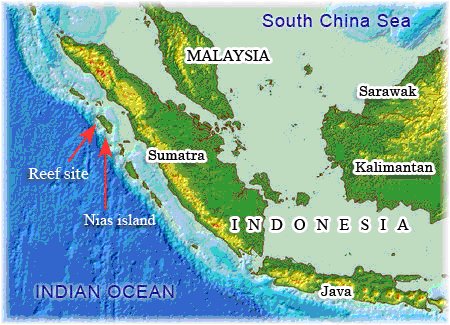
The Nias island just off Sumatra and origin to travel to the Island of the Skull
HISTORY
The WETA people have examined the ruins and determined that Skull Island endured three waves of history, the Prehistoric, the Fall of Civilization and the Denham years. The Prehistoric focuses on the original inhabitants up to the time when the interior was abandoned and before the Wall was built. The Fall comes from the abandonment of the interior up to the visit by Denham. Then the Denham years take over as the island is explored over the decades until Modern Times.
Here is what the WETA people believe happened:
Umpteen million years ago, India is moving north and slamming into the Eurasian Plate to form the Himalayas. The Australian plate is doing the same as it separates from the Pacific Plate and drives into the Eurasian. This causes a rupture just west of Sumatra to form the Islands of the Skull. Unfortunately, as the islands are on a plate junction, they are constantly under tectonic stress and the active volcanoes also destroy what they once created. Thus Skull island is constantly being created and destroyed. Doubtless the Eruption described by Carl Denham was but one of these constant eruptions.About 1000 bce, Asian peoples migrate down the Malay Peninsula into Indonesia, then from Sumatra, they island-hop west to eventually reach Skull Island. [The World of Kong- weta] Along the way, they find and domesticate the Kongs, a 15’ tall non-ape hominid, neither ape nor man but both and neither. [Valdron’s papers]
Den Valdron suggests that the Kongs had grown to size as they migrated west and were domesticated. The Kong may have helped them in construction and war as did the Asian Elephant on the Continent. Note that although estimates of the size of King Kong vary up to 40 feet tall, Carl Denham states that he saw Kong stand next to a pillar. He later measured the pillar to be 12’ and thus estimated Kong to be 15’ tall.
For the next two-thousand years, things settle in with the Colonists building a civilization that covers the island. This civilization venerates the Kong as labor (similar to domesticated elephants in India and Asia) and as a defense against the dinosaurs that inhabit the island.
About 1000 ce, the Asian colonists import oxen to the island which replace the Kongs as beasts-of-burden. This reduces the Kong from a vital and large population to a smaller but venerated group. From veneration, it is a short step to worship.
Around this time, the inhabitants are forced to abandon the interior of the island. They retreat to the beach and build a giant Wall to separate them from the dinosaurs. Note that they build a door large enough to allow the Kongs to pass through easily. Carl Denham believed that the Wall encircled the entire island.
As time passes, the Inhabitants divert more and more effort to the Wall which impoverishes the civilization and causes economic ruin among the people. Possibly slave raids to other islands are made and criminals are enslaved to work on the Wall. This is not unusual as the Fall of the Soviet Union was not created by a people wishing to be free for the Russians believed that they WERE free! Rather the collapse was because the USSR simply could no longer support the economic and manpower expense of their own Wall and the security necessary to protect their nation from imagined threats. The USA should take note of this.
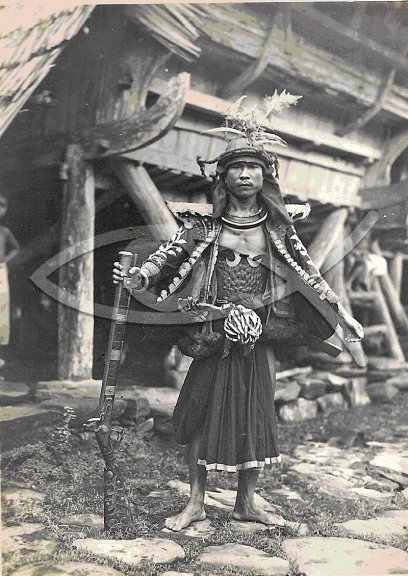
Nias islander before the introduction of international surfingThe Inhabitants eventually fade away, abandoning the island for the beach peninsula where they become a small village of Africans, speaking the Nias Language until Carl Denham arrives to disrupt their way of life.
There are a LOT of problems here.
I think that the solution is so simple, everyone missed it! The dinosaurs did not survive on the island, they immigrated to it!
- If the original inhabitants were Asians, where did the Negroes come from?
- How could a breeding population of dinosaurs survive for some 70 MILLION years on an island small enough to remain undiscovered?
- If the Inhabitants had the technology and military might to fight off the dinosaurs and arthropods for the centuries necessary to build their civilization, why abandon it?
- If the Wall is to keep the dinosaurs and kongs out of the village, why build a gate large enough for them to pass?
- And more!
AN ALTERNATE HISTORY
Skull Island (or Kong Island or Island of the Skull or whatever you want to call it today) was formed by volcanic activity along a fracture between two continental plates which form a series of islands that stretch from Skull Island to Sumatra.
The Asians island hopped down Indochina and across Indonesia. One group bounced off the Nias Islands then onto the islands that stretch west. They found the Island of the Skull which, being isolated, had no large animals and so they settled into this paradise. Along the way they fi\ound and domesticated the Kongs which were used as labor to build their civilization. Life is good!
Earthquakes happen and the intermediary islands between Skull Isl and Sumatra began to sink. About a thousand years ago, cattle were imported which replaced the kongs as a source of labor. It takes decades to train a kong to work, cattle can work after two years. Kongs produce one child every five years or so, cattle every year. Kongs are food intensive, cattle eat grass! The choice is clear, kong out, cattle in. The kongs were reduced from a vital source of labor to a smaller group of venerated beings. And it is a small step from veneration to adoration. Plus lacking the need to work, the kong population was reduced by restricted breeding and culling the infants.
As the islands sank due to volcanic activity, the trade routes vanished due to the inability of the Inhabitants to produce proper sea-going vessels capable of crossing the Ocean.
Now here is where it gets curious and we have a number of possible timelines to consider. Somewhere along this timeline, a migration from East Africa happened. Despite our belief in the savagery of the African peoples, many major leaps were made by those peoples. West African explorers reached Central America centuries before Columbus. East Africans were bypassing Indonesia to colonize Pacific Islands. For a voyage to stop at Skull Island is simple to imagine. If so, were they enslaved by the Asians? Or did that come later. We do not know when the Africans arrived, but they eventually did.
Option one is that the African colonists reached Skull Island and were enslaved.
Option two is that the Africans arrived and enslaved the Asians.
Option three is that the Africans arrived later and exterminated the Asians.
Option four is that the Africans arrived as the Asians were almost extinct and moved in.I believe in option number three for this reason!
How could a people capable of creating a Khmer-like civilization in the face of such giant arthropods and dinosaurs, suddenly be unable to even defend themselves?
I think that there were no dinosaurs when they arrived on Skull Island. If there were, they would have simply turned around and returned to the Nias Islands!
I think that the dinosaurs arrived AFTER the civilization was created!
I think that the Nias-Asians had it easy. They island hopped across the Indian Ocean, collecting the Kongs along the way, until they reached Skull Island. Then like the Polynesians who reached Hawaii, stopped voyaging and settled in. They built the Civilization and had a nice time, eventually importing cattle and reducing the kong to a small, venerated group.
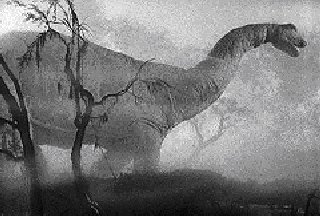
BrontosaurusTHEN, an eruption happened. Not unusual for they occurred every few years but this one as different. It opened a cave to the underworld! And from that underworld came giant arthropods! Crickets larger than dogs and Spiders big enough to eat cattle! The Islanders were hard-put to hold their own with these new monsters appearing and breeding faster than they could be killed. The islanders had to relearn war, and to train the kongs to kill. They did a quick-breeding program to turn the kong from a domestic laborer to a war-machine, bred to attack and kill anything larger than a person!
Then, just when they were barely holding their own (remember how much trouble the US has when faced by multitude giant spider invasions? We barely survive and we have modern weaponry at our disposal and thousands of miles to retreat to) the dinosaurs arrived!
So where did these things come from? There is only one place where dinosaurs can and do thrive, Pellucidar! I think that the latest earthquake opened a Migration Route to Pellucidar. Or to a mega-cavern inhabited by Pellucidarian immigrants. Maybe the one that led from Pellucidar to Dragon Island north of New Zealand [Doorways to Pellucidar: Zealandia by Rick Johnson] had an alternate path to Skull Island. But this path was rough enough so that only the biggest and meanest managed to make it out! Dragon Island may have had slurposaurs that could and would happily eat the giant bugs but for some reason, slurposaurs went up instead of west and the bugs bred uncontrollably! Thus the giant arachnids reached Skull island without the problems of being eaten and controlled by giant lizards! And then the true dinosaurs followed! Dinosaurs who saw the bugs as an irritant but not food. Why eat bugs when cattle and people are much more tasty? The Slurposaurs controlled the arthropods on Dragon Island (aka Zealandia) but their lack on Skull Island allowed the monsters to infest the place.
For a civilization facing the problems of giant spiders that bred faster than they could be killed, having a pack of 3-fingered Tyrannosaurs (Venatosaurus Rex) show up and eat the cattle AND the cow herders was too much.
The Nias fought back but lost! Without regular invasions to strengthen their army, they were weak and peaceful and easy prey and were exterminated.
So they retreated or were driven back to the beaches where they built the Wall as a last ditch protection. They had the kongs to help and so they built a door to allow the kongs to enter and leave as needed. Kongs that were trained and bred to kill every giant arthropod and dinosaur they saw. Even Denham observed kong attacking styracosaurs without provocation. The kongs attacked all and so the dinosaurs became aggressive. When kong took Ann, he paused to attack the brontosaur and stegosaur and styracosaurs and these in turn attacked the men that followed to rescue Ann.
Then, I believe the African migration arrived.
Did they attack the Asians or were they enslaved by the Asians? I don’t know. But they shared the beach long enough to learn the Nias language. Maybe they were enslaved, taught the language as a religious speech because that is how the Kongs were controlled, and one day when the kongs were inland, they revolted and exterminated the Asians, locking the gate to keep the kongs from returning. Then, they simply made regular sacrifices to Kong to keep him happy and on the other side of the Wall.
So the Africans settled down, diverted all their efforts to keep the Wall intact, thus impoverishing their civilization and they made due sacrifice to the kong-God, thus further reducing the breeding females in their population. For a small migrating group, decimated by conquering the Asians, the act of giving a single virgin every Full Moon to the Kongs was numerically devastating. They were on the downward path to oblivion and unable to see any way to stop.
Meantime the kongs are waging a war against the dinosaurs and arthropods. The invading monsters begin to kill the kong babies, but that is minor for the kongs bred so slowly and the dinosaurs so fast that the conclusion is inevitable. The race of kongs is dying as is the race of Africans outside the Wall.
The beach is too small to support enough farming for the tribe so they turn to fishing and one fishing canoe of Africans is blown away by a storm to be found by Capt Nils Helstrom, captain of a Barque, who questions the sole survivor. He draws a map based on the description of the island
Years later, Nils sells the map to Denham. More years later, Denham uses the map to visit Skull Island. King Kong & Son of Kong occur and Denham reports the island destroyed by earthquake. Various expeditions are sent to Skull island to study the island. (weta book) which is continually sinking. Until today!
I suspect that there are few dinosaurs left. There simply is not enough vegetation to support a breeding population of brontosaurs and stegosaurs. And there isn’t room for the numbers of brontosaurs to feed a breeding population of Venatosaurs. So they are dying off and if there are any left, they are the older ones that have been around since Denham. The arthropods probably eat the eggs as fast as they are laid and so the dinosaurs are approaching extinction as fast as are the Africans and the Asians and kongs before.
Then Skull island will be nothing but a haven for giant arthropods, waiting for a chance to colonize other islands or the mainland via storm or tsunami.
Of course, the Migration Route to Pellucidar, the one that feeds Dragon Island on the other side of Indonesia, may still remain open. If so, then more dinosaurs will arrive to replace the older ones, constantly migrating up to replace those that have dead. Or another volcanic eruption may have closed it, preventing replacements for the dead dinosaurs and effectively, transforming Skull Island into bug island.
If so, then Island of the Skull is yet another entrance to Pellucidar, one that I’d rather not explore because of the arthropods. I’d rather try one of the other paths.
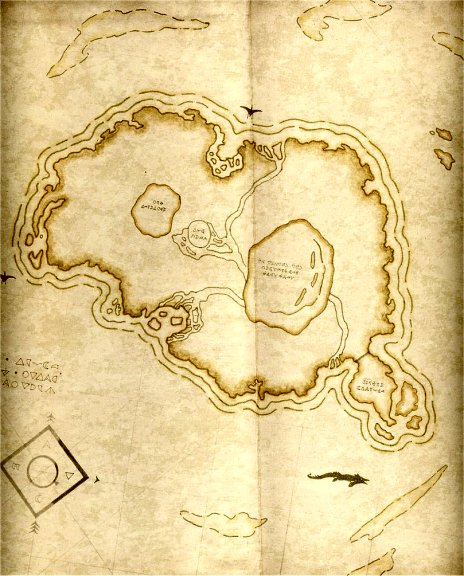
Devito 2004
|
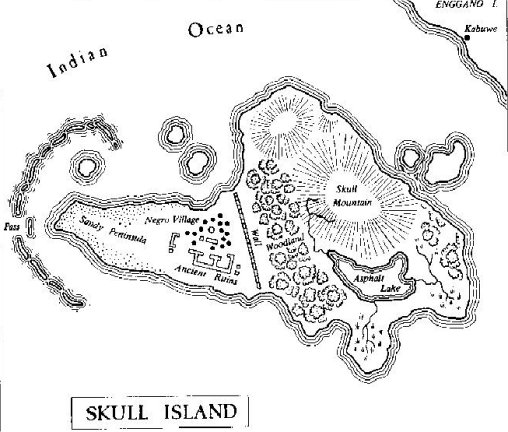
Skull Island by Captain Cook
|
BOOKS AND PAPERS OF VALUE
The World of Kong: A Natural History of Skull Island (King Kong) by Weta Workshop
Kong: King of Skull Island by Brad Strickland, Joe DeVito, John Michlig and Ray Harryhausen
King Kong (Modern Library Classics) by Delos Lovelace, Edgar Wallace, Merian C. Cooper and Greg Bear
King Kong by Christopher Golden
King Kong: The History of a Movie Icon from Fay Wray to Peter Jackson (Applause Books) by Ray Morton
The Girl in the hairy paw: King Kong as myth, movie, and monster (A Flare book) by Ronald Gottesman and Harry Geduld
DEN VALDRON'S PAPERS
CONTENTS: ERBzine 1402
King Kong I: the Lost Civilization of Skull Island - ERBzine 1520
King Kong II: How did that Monkey get so Big? - ERBzine 1521
Social History of King Kong
MY PAPERS
Doorways to Pellucidar: Zanthodon ~ ERBzine 3643
Doorways to Pellucidar: Zealandia ~ ERBzine 3671Rick Johnson Feature Articles and Fiction in ERBzine
NAVIGATION GUIDE : ERBzine 1645
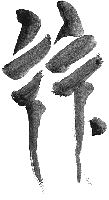
BILL HILLMAN
Visit our thousands of other sites at:
BILL and SUE-ON HILLMAN ECLECTIC STUDIO
ERB Text, ERB Images and Tarzan® are ©Edgar Rice Burroughs, Inc.- All Rights Reserved.
All Original Work ©1996-2012 by Bill Hillman and/or Contributing Authors/Owners
No part of this web site may be reproduced without permission from the respective owners.